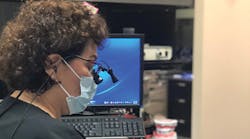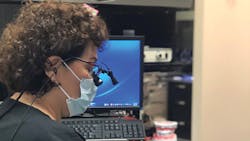What’s behind our resistance to changing clinical technologies, and how can we overcome this?
A change…
(A change would do you good)
…would do you good
(A change would do you good)
—Sheryl Crow
Eileen Morrissey, MS, RDH
As a speaker, educator, and practicing dental hygienist, I teach many continuing education courses. One of my favorites is an interactive problem-solving seminar that encourages hygienists to resolve clinical challenges. In these seminars, a complaint against younger hygienists frequently arises. The gist of it is this: Many “seasoned” clinicians look disparagingly at hygienists who reach for ultrasonic scalers as the instrument of choice for initial debridement (and sometimes complete scaling). For those who take issue with this practice, a know-it-all attitude pervades their comments, which basically can be summed up in this question: “Why aren’t younger hygienists removing deposits the tried-and-true way—by hand scaling?!”
In these situations, I find myself explaining that contemporary hygienists are taught in school that ultrasonics are multifaceted. In addition to removing deposits and stains efficiently, patients receive the benefit of lavage along with disruption of bacterial cell walls in biofilm. (This applies to patients without calculus, too.) Also, patients with periodontal issues are extremely well served. Ultrasonics, however, cannot be a replacement for the precision of hand-scaling, which is integral to producing an ultraclean root and tooth surface. If we hygienists want to save time—as well as our hands, wrists, and forearms—it behooves us to embrace ultrasonics. Best care utilizes both.
Yet, despite this explanation, a significant number of clinicians shrug their shoulders and cling to their old ways. Why is this the case? Why is there such resistance to change?
As a useful comparison, consider this similar situation: Each time I present CE, I query those in attendance as to how many use loupes. The numbers are staggeringly low. I then display an image of a probe in a sulcus viewed with zero magnification. Adjacent to the image is the same probe in the same sulcus but viewed with 2.5x magnification (hygienists’ favorite). The contrast is startling. I read almost daily about hygienists who are thinking of leaving the profession because their necks, shoulders, and backs regularly hurt. Because their bodies are breaking down, the stress levels of these hygienists are higher. Moreover, conditions within patients’ mouths are challenging to see because of these hygienists’ aging eyes. What’s the prognosis for these hygienists? Things will only worsen with time. After I’ve made these points, we speak about the use of loupes and how they can improve conditions for hygienists and patients.
I recently became a national dental hygiene educator for Q-Optics. I meet dental hygiene students regularly who invest in loupes because this technology is the new standard of care and has significant ergonomic benefits. These hygienists understand this early in their careers largely thanks to their learning institutions. Compare this with the “seasoned” clinicians I referenced earlier. They were trained more than 15 years ago, when loupes were not mainstream. These clinicians appearto be listening as I report on the current state of affairs, yet, in the end, only some jump on board and embrace change. Cost, fear, and failure to see the value are cited as reasons not to change. Hearing this time and time again inspired me to write this article. Why would hygienists not purchase a tool that will help lengthen their careers? And why would hygienists not choose to use ultrasonics, given the documented efficiency and ergonomic advantages? In short, why is change so difficult?
To answer this question, let’s look at some research on behavior. Ralph Ryback, MD, notes the following: “As creatures of habit, we often have difficulty incorporating new changes into our routines, no matter how beneficial they are for us, because we tend to do the things that make us feel good, secure, and comfortable.”1
OK. I get this. We know that loupes and ultrasonics will make our lives easier. We’ve been educated and enlightened on this point. Furthermore, we all have colleagues who practice dental hygiene using these instruments. Yet, being creatures of habit, the propensity to resist anything that will force us off autopilot looms large.
Dr. Ryback adds, “Inertia, or ‘a tendency to do nothing or to remain unchanged,’ is at the headwinds of any alteration that we make in our lives. […] Our bodies’ complex inertia, or resistance to change, is important for maintaining a state of equilibrium known as homeostasis. Homeostasis helps our bodies to maintain a normal body temperature, metabolism, weight, and other [conditions] that are necessary for our survival.”1
What?! Detectable, physiological events take place when we try to change? Looked at another way, is this part of the reason why starting a new diet or exercise routine often fails, despite the fact that the changes are beneficial?
The problem seems to be that our resistance to change can be indefinitely perpetuated by our current habits. As Your Positivity Coach puts it, “Once a habit is formed, we often don’t even realize it’s there anymore. We still get the short-term reward for the habit, but it can often cause discouragement and anxiety in our [lives] because it’s not really what we want to be doing.”2
If we are working without loupes or refusing to embrace ultrasonics, deep down we might be left with a sinking sensation. The sensation will come up when we read of these technologies’ importance, when we hear the buzz about these devices from colleagues, or when we are left with the day-to-day aches and pains that our professional responsibilities perpetuate.
Is there a solution? How can we embrace change rather than resist it? Top lifestyle coaches from the Forbes Coaches Council have offered 12 ways to overcome resistance.3 My favorites are these:
First, David Butlein recommends adopting a learning mindset. “Resisting change is resisting reality. Instead of working so hard to keep things the same, how can you befriend this fact of life?”3
Second, Gina Gomez says to believe that change will serve you and others well. In doing so, you will rewire your internal, negative thinking. Believe that change will be positive and it becomes a self-fulfilling prophecy.3
Finally, John O’Connor recommends finding a mentor. Have someone in your life to lean on and consult with professionally. It can make a huge difference as you transition through the change.3
The use of loupes and ultrasonics are just two examples of challenges that some hygienists face. But all of us have clinical Everests that we have to climb. Onward we go—it is in our hearts’ core.
References
1. Ryback R. Why we resist change. Psychology Today website. https://www.psychologytoday.com/us/blog/the-truisms-wellness/201701/why-we-resist-change. Published January 25, 2017.
2. You can’t change because you won’t change. Your Positivity Coach website. http://yourpositivitycoach.com/cant-change-wont-change/. Published August 8, 2016.
3. Forbes Coaches Council. 12 ways to overcome your resistance to change. Forbes website. https://www.forbes.com/sites/forbescoachescouncil/2017/12/11/12-ways-to-overcome-your-resistance-to-change/#3707fbff5833. Published December 11, 2017.
Further reading
1. Winerman L. Changing our brains, changing ourselves. American Psychological Association website. https://www.apa.org/monitor/2012/09/brains. Published September 2012.
2. Polman E, Ruttan RL, Peck J. Using curiosity to increase the choice of “should” options. https://www.apa.org/news/press/releases/2016/08/using-curiosity.pdf.
3. Elster J. Ulysses revisited: How and why people bind themselves. In: Ulysses Unbound: Studies in Rationality, Precommitment, and Constraints. Cambridge: Cambridge University Press; 2000:1-87.
Eileen Morrissey, MS, RDH, is an educator, clinician, writer, and national lecturer. She is an adjunct dental hygiene faculty member at Rowan College at Burlington County, New Jersey, and a national dental hygiene educator for Q-Optics. Reach her at [email protected] or (609) 259-8008. Visit her website at eileenmorrissey.com.







